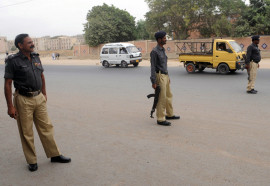
Firstly, it is being reported that the black box of the ill-fated A321, which went down in the Daman-e-Koh area of the Margalla Hills on Wednesday, is yet to be located, despite the passage of close to two days.
The Airblue airliner, flown by a complement of two pilots, had a Digital Flight Data Recorder (DFDR) – commonly referred to as the black box – capable of withstanding the sort of G-Loads impact experienced by ED202, and worse.
The DFDR starts emitting electronic signals on impact which helps locate its exact location – even in extreme cases such as when the aircraft debris rests thousands of feet below the sea surface.
Its location can be pinpointed using special detection equipment, which the country’s Civil Aviation Authority (CAA) should possess; if not, it would definitely be available with the army aviation or the air force.
In the flight operated by Capt Pervaiz Iqbal Chaudhry, the DFDR was secured in the tail section, which is always the case in aircraft. It is concealed in a shock-proof, crash-proof sealed unit, painted with a special translucent orange paint that makes it resistant to environmental wear and tear and to ensure that it is easily visible.
There is no possibility of the DFDR not being found if proper equipment is available. However, it would be difficult to locate through the naked eye by unskilled searchers.
The black box records a number of flight-related parameters, which can extend to almost 88 in number, depending on the type of DFDR installed. These parameters include time, altitude, vertical acceleration, airspeed, Pitch Attitude, time of contact with control tower, engine parameters, thrust settings of each engine, position of flight controls, longitudinal axis, etc.
The Cockpit Voice Recorder retains the last 30 minutes of conversations that took place in the cockpit between the pilots and/or with anyone else. A recording of the conversation between the tower and pilots is also maintained separately by the Air Traffic Controllers and the Radar Controllers.
Investigators will probe into the reason why the ill-fated aircraft made a Go-Around while approaching Runway 30 at Benazir Bhutto International. The METAR reveals that at 9 am the wind was 050/16 Knots and visibility was 3.5 Kilometres. There were scattered clouds at 3,000 feet, overcast at 1,000feet. At 10 am, the METAR reports a wind of 090/18 knots and visibility of 3,500 metres.
Apart from the unfavourable tailwind factor, the only other possibility is that the pilot might have experienced some wind shear, which was not reported by the tower, or that he lost visual contact with the runway at 200 feet above ground level – which is the minimum height required for the CAT 1 ILS system that was installed on Runway 30.
In case of poor visibility or runway obscured by low clouds, it makes no sense to make a visual circling approach for Runway 12, which has a higher visibility requirement, unless it was a case of a passing cloud.
Capt Iqbal Chaudhry, in spite of his age was a very experienced pilot, who had made more than a thousand approaches at Islamabad airport. Investigators will also probe into the flight experience of the copilot, who, it has been reported, was just doing his second flight.
It is doubtful that the copilot would have been of any assistance to the pilot, or that the pilot would have had any confidence in him because of his limited flying experience on such aircraft. Modern aircraft flying in congested traffic, with dicey weather, requires a team effort in case of an emergency.
Also will be investigated is the condition of the aircraft, which was relatively new, regarding its maintenance status and history of defects.
The pilots’ medical history and recent flight records will be probed. Airblue management will be required to answer a lot of questions. Similarly, the grant of waivers for pilots having an existing medical condition to fly above the age of superannuation also needs to be probed.
It also needs to be investigated why special fire fighting extinguishers used to fight jet fuel fires or fire originating from liquid gasoline was not used during the rescue operation. As it is, water, and rain water, would have acted as a catalyst for more fire when mixed with unburnt fuel.
It is also surprising that the CEO of Airblue Mr Shahid Khaqan Abbasi, who is a sitting MNA, has abstained from the media eye and is avoiding questions. He has a lot to explain. For example, does Airblue provide its pilots with round the clock medical facilities so that their fitness can be ensured?
In the end, the authenticity and credibility of the investigations depends upon the choice of investigators given the task, and whether they will be independent of the CAA, Airblue and Airbus, all of whom have stake in this investigation.
An independent Accident Investigation body like the NTSB (National Transport Safety Board) needs to be set up. Pakistan historically has a poor reputation in covering up all previous investigations into air accidents. This lack of professional ethics has led to compromises on flight safety of passengers, who are the ultimate losers. The lives of 152 souls would be lost in vain if the investigation is not carried our transparently. It is also time to realise that National Disaster Management lacks any professional skills and competence to handle any disaster. It neither has the capacity, nor the equipment to handle a situation, which defeats the very purpose behind setting it up.
Published in The Express Tribune, July 30th, 2010.



1730788481-0/BeFunky-collage-(19)1730788481-0-165x106.webp)


1730786905-0/£300,000-(1)1730786905-0.png)








1730706072-0/Copy-of-Untitled-(2)1730706072-0-270x192.webp)
COMMENTS (2)
Comments are moderated and generally will be posted if they are on-topic and not abusive.
For more information, please see our Comments FAQ